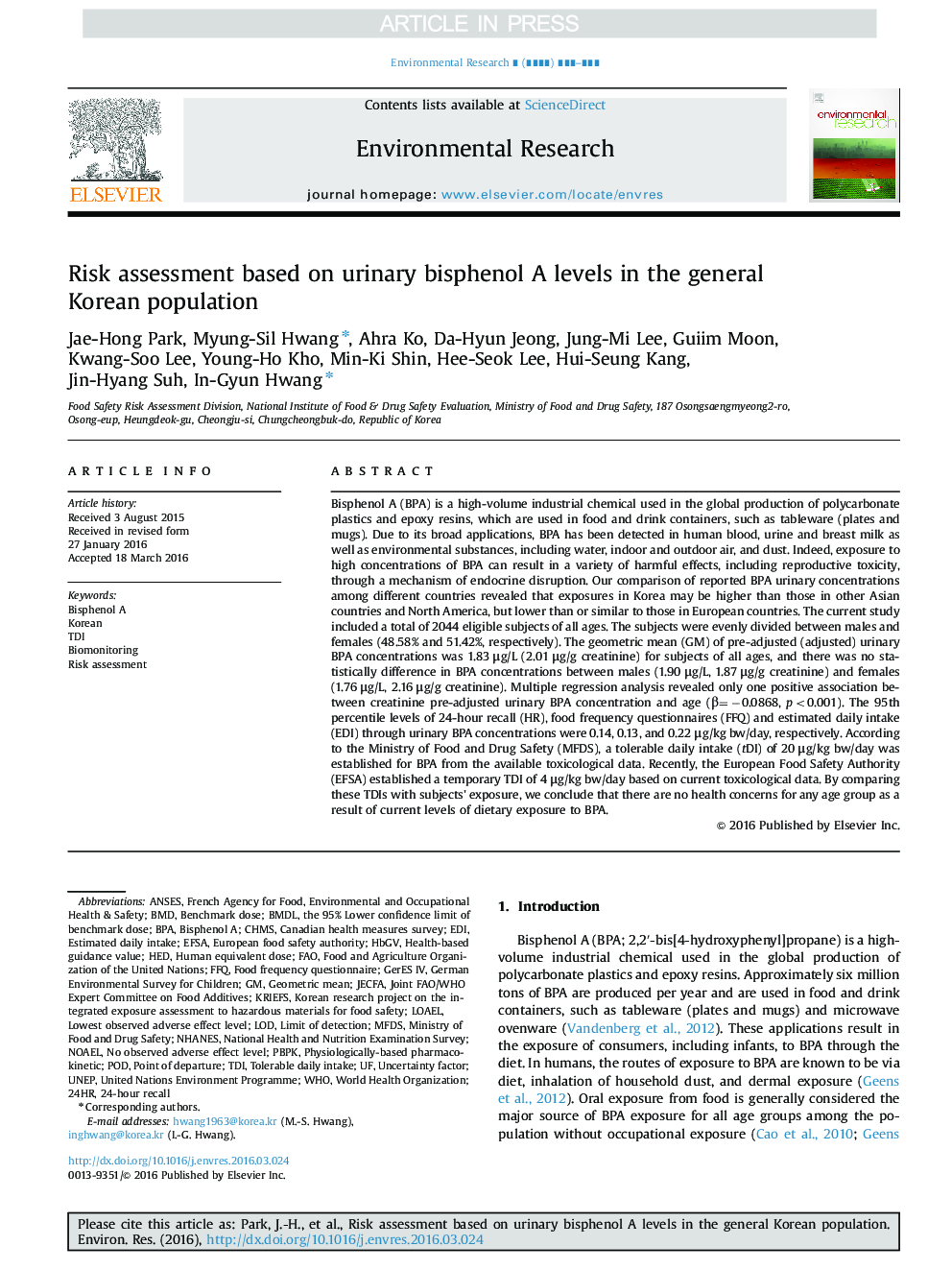| کد مقاله | کد نشریه | سال انتشار | مقاله انگلیسی | نسخه تمام متن |
|---|---|---|---|---|
| 6351099 | 1622553 | 2016 | 10 صفحه PDF | دانلود رایگان |
عنوان انگلیسی مقاله ISI
Risk assessment based on urinary bisphenol A levels in the general Korean population
ترجمه فارسی عنوان
ارزیابی خطر بر اساس سطوح بیسفنول ادراری در کل جمعیت کره ای
دانلود مقاله + سفارش ترجمه
دانلود مقاله ISI انگلیسی
رایگان برای ایرانیان
کلمات کلیدی
BPAHealth-based guidance valueBMDLJECFAEDIBMDEFSAFFQHEDCHMSFrench Agency for Food, Environmental and Occupational Health & SafetyEuropean Food Safety Authority - اداره ایمنی اروپاCanadian Health Measures Survey - بررسی اقدامات بهداشتی کاناداییBisphenol A - بیسفنول ای، بیسفنول AEstimated daily intake - تخمینی مصرف روزانهANSES - در نظر گرفتهbenchmark dose - دوز معادلHuman equivalent dose - دوز معادل انسانیFood and Agriculture Organization of the United Nations - سازمان غذا و کشاورزی سازمان ملل متحدFAO - فائوJoint FAO/WHO Expert Committee on Food Additives - مجمع متخصص FAO / WHO در مورد مواد افزودنی مواد غذاییGeometric mean - میانگین هندسیFFQ, Food Frequency Questionnaire - پرسشنامه بسامد خوراک، پرسشنامه بسامد مصرف غذایی
موضوعات مرتبط
علوم زیستی و بیوفناوری
علوم محیط زیست
بهداشت، سم شناسی و جهش زایی
چکیده انگلیسی
Bisphenol A (BPA) is a high-volume industrial chemical used in the global production of polycarbonate plastics and epoxy resins, which are used in food and drink containers, such as tableware (plates and mugs). Due to its broad applications, BPA has been detected in human blood, urine and breast milk as well as environmental substances, including water, indoor and outdoor air, and dust. Indeed, exposure to high concentrations of BPA can result in a variety of harmful effects, including reproductive toxicity, through a mechanism of endocrine disruption. Our comparison of reported BPA urinary concentrations among different countries revealed that exposures in Korea may be higher than those in other Asian countries and North America, but lower than or similar to those in European countries. The current study included a total of 2044 eligible subjects of all ages. The subjects were evenly divided between males and females (48.58% and 51.42%, respectively). The geometric mean (GM) of pre-adjusted (adjusted) urinary BPA concentrations was 1.83 μg/L (2.01 μg/g creatinine) for subjects of all ages, and there was no statistically difference in BPA concentrations between males (1.90 μg/L, 1.87 μg/g creatinine) and females (1.76 μg/L, 2.16 μg/g creatinine). Multiple regression analysis revealed only one positive association between creatinine pre-adjusted urinary BPA concentration and age (β=â0.0868, p<0.001). The 95th percentile levels of 24-hour recall (HR), food frequency questionnaires (FFQ) and estimated daily intake (EDI) through urinary BPA concentrations were 0.14, 0.13, and 0.22 μg/kg bw/day, respectively. According to the Ministry of Food and Drug Safety (MFDS), a tolerable daily intake (tDI) of 20 μg/kg bw/day was established for BPA from the available toxicological data. Recently, the European Food Safety Authority (EFSA) established a temporary TDI of 4 μg/kg bw/day based on current toxicological data. By comparing these TDIs with subjects' exposure, we conclude that there are no health concerns for any age group as a result of current levels of dietary exposure to BPA.
ناشر
Database: Elsevier - ScienceDirect (ساینس دایرکت)
Journal: Environmental Research - Volume 150, October 2016, Pages 606-615
Journal: Environmental Research - Volume 150, October 2016, Pages 606-615
نویسندگان
Jae-Hong Park, Myung-Sil Hwang, Ahra Ko, Da-Hyun Jeong, Jung-Mi Lee, Guiim Moon, Kwang-Soo Lee, Young-Ho Kho, Min-Ki Shin, Hee-Seok Lee, Hui-Seung Kang, Jin-Hyang Suh, In-Gyun Hwang,
